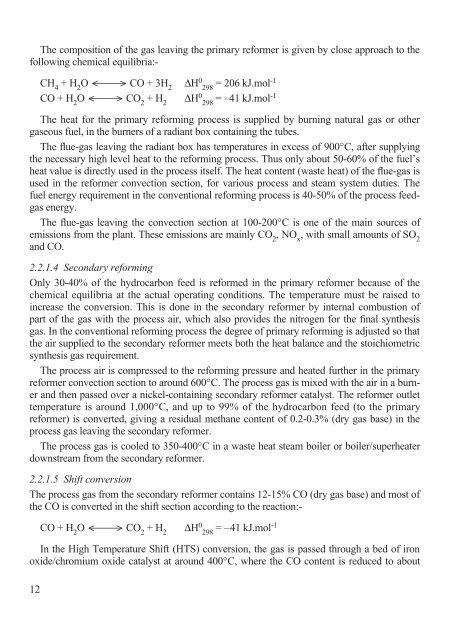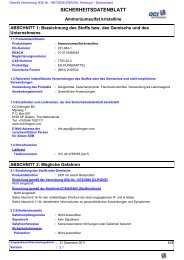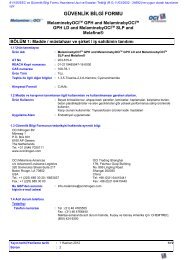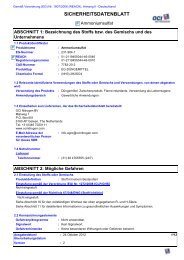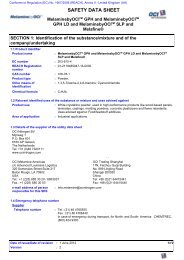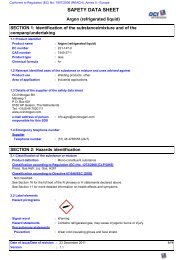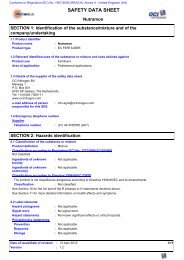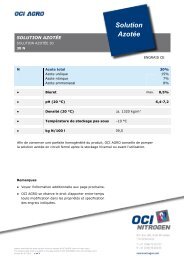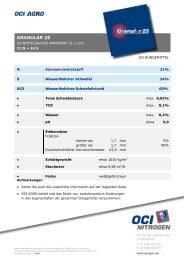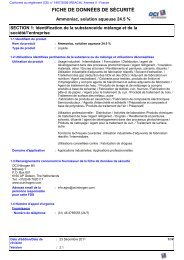PRODUCTION OF AMMONIA - OCI Nitrogen
PRODUCTION OF AMMONIA - OCI Nitrogen
PRODUCTION OF AMMONIA - OCI Nitrogen
Create successful ePaper yourself
Turn your PDF publications into a flip-book with our unique Google optimized e-Paper software.
The composition of the gas leaving the primary reformer is given by close approach to the<br />
following chemical equilibria:-<br />
12<br />
CH4 + H2O CO + 3H2 ΔH0 298 = 206 kJ.mol-1<br />
CO + H2O CO2 + H2 ΔH0 298 = –41 kJ.mol-1<br />
The heat for the primary reforming process is supplied by burning natural gas or other<br />
gaseous fuel, in the burners of a radiant box containing the tubes.<br />
The flue-gas leaving the radiant box has temperatures in excess of 900°C, after supplying<br />
the necessary high level heat to the reforming process. Thus only about 50-60% of the fuel’s<br />
heat value is directly used in the process itself. The heat content (waste heat) of the flue-gas is<br />
used in the reformer convection section, for various process and steam system duties. The<br />
fuel energy requirement in the conventional reforming process is 40-50% of the process feedgas<br />
energy.<br />
The flue-gas leaving the convection section at 100-200°C is one of the main sources of<br />
emissions from the plant. These emissions are mainly CO 2 , NO x , with small amounts of SO 2<br />
and CO.<br />
2.2.1.4 Secondary reforming<br />
Only 30-40% of the hydrocarbon feed is reformed in the primary reformer because of the<br />
chemical equilibria at the actual operating conditions. The temperature must be raised to<br />
increase the conversion. This is done in the secondary reformer by internal combustion of<br />
part of the gas with the process air, which also provides the nitrogen for the final synthesis<br />
gas. In the conventional reforming process the degree of primary reforming is adjusted so that<br />
the air supplied to the secondary reformer meets both the heat balance and the stoichiometric<br />
synthesis gas requirement.<br />
The process air is compressed to the reforming pressure and heated further in the primary<br />
reformer convection section to around 600°C. The process gas is mixed with the air in a burner<br />
and then passed over a nickel-containing secondary reformer catalyst. The reformer outlet<br />
temperature is around 1,000°C, and up to 99% of the hydrocarbon feed (to the primary<br />
reformer) is converted, giving a residual methane content of 0.2-0.3% (dry gas base) in the<br />
process gas leaving the secondary reformer.<br />
The process gas is cooled to 350-400°C in a waste heat steam boiler or boiler/superheater<br />
downstream from the secondary reformer.<br />
2.2.1.5 Shift conversion<br />
The process gas from the secondary reformer contains 12-15% CO (dry gas base) and most of<br />
the CO is converted in the shift section according to the reaction:-<br />
CO + H2O CO2 + H2 ΔH0 298 = –41 kJ.mol-1<br />
In the High Temperature Shift (HTS) conversion, the gas is passed through a bed of iron<br />
oxide/chromium oxide catalyst at around 400°C, where the CO content is reduced to about


